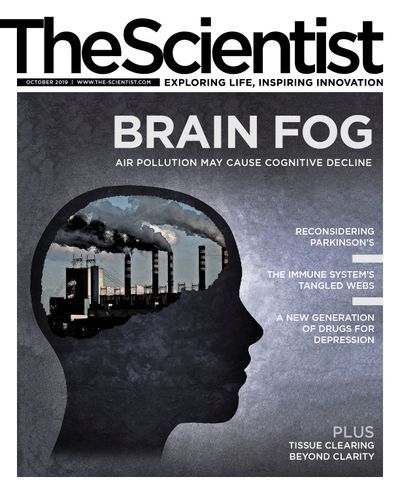Login
SubscribeFeatures

Air Pollution May Damage People’s Brains
Catherine Offord | Oct 1, 2019 | 10+ min read
Contaminants in the atmosphere appear to have harmful effects on neurodevelopment and cognitive function.

Is It Time to Rethink Parkinson’s Pathology?
Ashley Yeager | Oct 1, 2019 | 10+ min read
New evidence points to a waste-clearing problem in patients’ cells, rather than the accumulation of protein tangles, as the root cause of the neurodegenerative disease.

Why Immune Cells Extrude Webs of DNA and Protein
Borko Amulic and Gabriel Sollberger | Oct 1, 2019 | 10 min read
Extracellular webs expelled by neutrophils trap invading pathogens, but these newly discovered structures also have ties to autoimmunity and cancer.
Contributors
Contributors
Contributors
Meet some of the people featured in the October 2019 issue of The Scientist.
Editorial
The Human Brain: Blessing and Curse
The Human Brain: Blessing and Curse
Our brains are mysterious, fragile, and mischievous. That’s what makes them fascinating.
Speaking of Science
Ten Minute Sabbatical
Ten Minute Sabbatical
Take a break from the bench to puzzle and peruse.
Freeze Frame
Caught on Camera
Caught on Camera
Selected Images of the Day from the-scientist.com
Notebook
Time Spent in Nature Is Good for You
Time Spent in Nature Is Good for You
Research has repeatedly suggested that spending time in natural environments improves mental and physical well-being. Now, scientists are gathering the data needed to incorporate this phenomenon in health-care guidelines.
When Humans Hear Music, Monkeys May Hear Noise
When Humans Hear Music, Monkeys May Hear Noise
The auditory cortices of humans and rhesus monkeys respond very differently to harmonic tones.
Genetic Risk for Alzheimer’s Disease Linked to Highly Active Brains
Genetic Risk for Alzheimer’s Disease Linked to Highly Active Brains
A growing body of evidence supports the theory that neural hyperactivity and hyperconnectivity precede the pathological changes that lead to neurodegeneration.
The Narluga: New Insights from Old Bones
The Narluga: New Insights from Old Bones
DNA analysis of a bizarre, 30-year-old whale skull serves as a reminder of the secrets that museum specimens keep about the natural world.
Critic at Large
Opinion: Develop Organoids, Not Chimeras, for Transplantation
Opinion: Develop Organoids, Not Chimeras, for Transplantation
Scientists are devising human-animal hybrids for harvesting human organs, but lab-derived mini-organs are a less ethically fraught solution to meeting the need for transplantation.
Modus Operandi
Remote Control of Peripheral Nerves
Remote Control of Peripheral Nerves
An implantable wireless device with microfluidic and optical components allows manipulation of individual nerve fibers in mice’s extremities.
The Literature
Glowing Proteins Enable Stem Cell Stimulation for Stroke Recovery in Mice
Glowing Proteins Enable Stem Cell Stimulation for Stroke Recovery in Mice
A new method helps neural stem cells form synaptic connections, thereby restoring lost brain function.
Could Brain Activity During Sleep Be a Biomarker for Alzheimer’s?
Could Brain Activity During Sleep Be a Biomarker for Alzheimer’s?
Changes in brain waves while snoozing correlate with accumulation of tau and amyloid-β, suggesting that the neural activity disruptions could clue doctors in to early development of the disease.
Paternal Age Linked to Brain Abnormalities Associated with Autism
Paternal Age Linked to Brain Abnormalities Associated with Autism
Brain scans of autistic and non-autistic men reveal an association between white matter aberrations and the ages of their fathers at the time the sons were born.
Profile
The Cerebellum’s Secrets: A Profile of Kamran Khodakhah
The Cerebellum’s Secrets: A Profile of Kamran Khodakhah
The Albert Einstein College of Medicine neuroscientist has revealed surprising functions of the brain region, such as its role in the brain’s rewards circuits and in addiction.
Scientist to Watch
Johannes Kohl Untangles the Neural Circuitry Behind Instinct
Johannes Kohl Untangles the Neural Circuitry Behind Instinct
The Francis Crick Institute neurobiologist aims to learn how physiological states, such as hunger, alter information processing in the brain.
Lab Tools
New Tissue Clearing Methods Offer a Window into the Brain
New Tissue Clearing Methods Offer a Window into the Brain
Researchers are developing a variety of approaches for clearing neural tissue to get a better view of the brain’s circuitry.
Bio Business
Antidepressant Approvals Could Herald New Era in Psychiatric Drugs
Antidepressant Approvals Could Herald New Era in Psychiatric Drugs
The FDA has given the green light to the first major new classes of antidepressant therapies in decades, opening up new avenues for therapeutic development.
Reading Frames
Opinion: Why Mammalian Brains are Geared Toward Kindness
Opinion: Why Mammalian Brains are Geared Toward Kindness
Neuroscience is starting to unravel the evolutionary underpinnings of mammals’ selflessness.
Foundations
Wine Therapy, Middle Ages
Wine Therapy, Middle Ages
The beverage was a popular tonic and antiseptic.
Infographics
Infographic: Is Cellular Waste at the Root of Parkinson’s Disease?
Infographic: Is Cellular Waste at the Root of Parkinson’s Disease?
Damage to the lysosome, the organelle that removes excess proteins, lipids, and other materials, might be at the root of the disease.
Infographic: How NETs Work
Infographic: How NETs Work
While neutrophil extracellular traps help guard the body from infection, they also can contribute to a range of diseases.
Infographic: How Air Pollution Could Affect the Brain
Infographic: How Air Pollution Could Affect the Brain
Evidence is accumulating that breathing contaminated air might impair cognition.
Infographic: Light in the Dark
Infographic: Light in the Dark
A new tool helps stem cells integrate with host neural circuitry after implantation in mice.
Infographic: Remote-Controlled Nerves
Infographic: Remote-Controlled Nerves
A tiny implanted optofluidic device enables researchers to control mouse nerves without touching the animals.
























